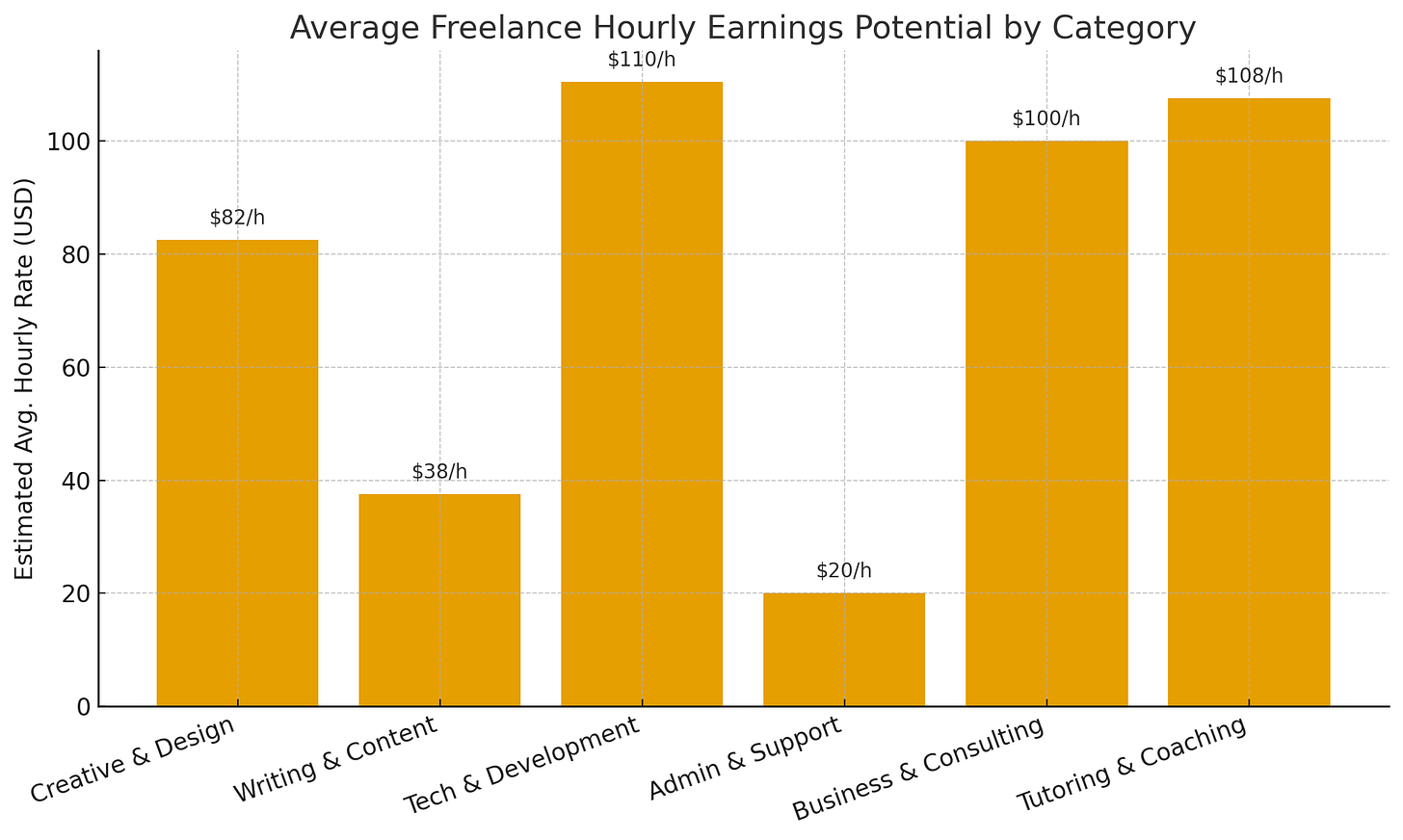Which Freelance Jobs Actually Pay Well (and Which Don’t)
A 360° breakdown of six freelancing categories. With real pay rates, AI risks, and success stories.
Every month, millions of people search the same question:
Which freelance job is actually worth it?
The truth: freelancing isn’t one single market. It’s many very different categories, each with different pay levels, demand, risks, and paths to growth. Some jobs can get you earning within a week, others take months of portfolio building. Some are already being replaced by AI, while others are more resilient than ever.
This article breaks down freelancing into six categories and compares them on earnings, demand, scalability, and automation risk. If you’re trying to decide “where should I start?” or “which niche is safest for the future?”, this guide will give you the real economics, not the hype.
FAQ: Fast answers before we dive in
What is the highest-paying freelance job?
Tech & Development and Business & Consulting consistently offer the best hourly rates and retainers.
Which freelance jobs are most at risk from AI?
Generic blog writing, low-level admin work, and basic design are most exposed.
What are the easiest freelance jobs to start with?
Admin support, tutoring, and entry-level content writing are the fastest entry points.
Which platforms are best for freelancers?
Upwork (broad coverage), Fiverr (fastest entry), and vetted platforms like Toptal or Catalant for premium clients.
Can freelancing replace a full-time job?
Yes, but not equally across categories. Developers, consultants, and specialized writers often scale to six figures. Admin or entry-level gigs remain supplemental.
💡 This article is part of Side Hustles & Businesses — a series of practical guides to help you start and grow your next project.
If you’re reading this, you might also want to check out:
✉️ Subscribe to the newsletter to stay updated on what’s working in digital business.
In the premium section, we break down six major freelancing categories using a structured framework of nine critical details. Each one is explained in practical terms, so you can see exactly what matters before investing your time or money:
Earnings potential. Realistic hourly and project rates. Crucial to understand whether the work pays at a survival level, a comfortable level, or truly scales into six figures.
Time to first dollar. How quickly you can start earning. Some paths let you land paid gigs within days, others require months of portfolio-building or training.
Startup costs. The upfront investment needed — from software to certifications. Important to know if you can bootstrap or need significant capital.
Market demand. How much clients are actually hiring in this category today and in the future. Demand determines whether your pipeline is full or dry.
AI risk. Exposure to automation or generative AI tools. Some jobs are already shrinking, others are more resilient. Knowing this protects you from picking a “sunset” path.
Scalability. Whether the work grows beyond your personal hours. Many freelance jobs cap at what you can do in a day, while others can be productized or turned into agencies.
Volatility. How stable or unstable the demand is. Helps you gauge whether income is predictable or tied to seasonal cycles and economic swings.
Client types. Who actually pays for this work — individuals, small businesses, corporates. This shapes your pricing, positioning, and the way you market yourself.
A real freelancer story. Because numbers don’t tell the whole picture, each category includes a story of someone who made it work — showing not only what’s possible, but how they got there.
Taken together, these nine details give you a realistic, 360° view of freelancing. They show not just how much money is on the table, but also the hidden risks, the time horizons, and the growth opportunities that you won’t see in “top 10 freelance jobs” lists elsewhere online.
At a glance: each category
Creative & Design – High ceilings for senior roles like branding and UX, but entry-level design is being automated by Canva and AI tools. Winning freelancers climb “up the value chain” by offering strategy.
Writing & Content – A giant market, but uneven. Commodity content is shrinking, while niches like SaaS, fintech, and health remain lucrative. Specialization beats volume.
Tech & Development – The best-paid niche. Demand is exploding, especially in cybersecurity and integrations. AI helps coders but can’t replace senior engineers.
Admin & Support – Easy entry, but low pay and high automation risk. Often a launchpad rather than a career.
Business & Consulting – High-value work with SMEs and corporates. Requires experience but pays with retainers and project-based pricing.
Tutoring & Coaching – Growing with e-learning. Language tutors start low, but coding prep and test coaching can pay premium rates.
Next chart reveals where the real money is in freelancing. Tech & Development, Tutoring & Coaching, and Business & Consulting pull in premium rates, while Admin & Support lags behind. The takeaway? If you want to play in the top tier, aim for skills that combine expertise with high client demand.


